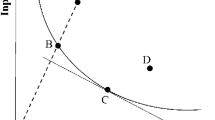Abstract
In this paper we intend to establish relations between the way efficiency is measured in the literature on efficiency analysis, and the notion of distance in topology. In particular we study the Holder norms and their relationship to the shortage function (Luenberger (1995) and the directional distance function (Chambers, Chung and Färe (1995–96)). Along this line, we provide mathematical programs to compute the Holder distance function. However, this has a perverse property that undermines its attractiveness: it fails the commensurability condition suggested by Russell (1988). Thus, we introduce a commensurable Holder distance function invariant with respect to a change in the units of measurement. Among other things we obtain some continuity result and we prove that the well known Debreu-Farrell measure is a special case of the Holder distance function.
Similar content being viewed by others
References
Afriat, S. (1972). “Efficiency Estimation of Production Function.” International Economic Review 13, 568–598.
Banker, R. D., A. Charnes, and W. W. Cooper. (1984). “Some Models for Estimating Technical and Scale Efficiency in Data Envelopment Analysis.” Management Science 30, 1078–1092.
Banker, R. D., and Morey. (1986). “Efficiency Analysis for Exogenously Fixed Inputs and Outputs.” Operation Research 34, 513–552.
Briec, W. (1995). Une nouvelle approche de la mesure de l'efficacité productive, PH.D dissertation, Ecole des Hautes Etudes en Sciences Sociales–GREQAM.
Briec, W. (1997). “A Graph Type Extension of Farrell Technical Efficiency Measure.” Journal of Productivity Analysis 8, 95–110.
Briec, W. (1997). “Minimum Distance to the Complement of a Convex Set: Duality Result.” Journal of Optimisation Theory and Application 95, 301–319.
Chambers, R., Y. Chung, and R. Färe. (1995). “Benefit and Distance Functions.” Journal of Economic Theory 70, 407–419.
Chambers, R., Y. Chung, and R. Fére. (1996). “Profit, Directional Distance Functions, and Nerlovian Efficiency.” Journal of Optimization Theory and Applications, forthcoming.
Charnes, A., W. W. Cooper, and E. Rhodes. (1978). “Measuring the Efficiency of Decision-Making Units.” European Journal of Operational Research 3, 429–444.
Debreu, G. (1951). “The Coefficient of Resource Utilization.” Econometrica 19, 273–292.
Eichorn, W., and J. Voeller. (1976). Theory of Price Index: Fisher's Test Approach and Generalizations (Lecture Notes in Operations Research and Mathematical Systems, Vol. 140). Berlin, Heidelberg, New York: Springer-Verlag.
Färe, R., and C. A. K. Lovell. (1978). “Measuring the Technical Efficiency of Production.” Journal of Economic Theory 19, 150–162.
Fére, R., and S. Grosskopf. (1983). “Measuring Congestion in Production.” Zeitschrift für Nationalkönomie 43, 257–271.
Färe, R., S. Grosskopf, and C. A. K. Lovell. (1985). The Measurement of Efficiency of Production. Kluwer Nijhof Publishing.
Füre, R., S. Grosskopf, and C. A. K. Lovell. (1994). Production Frontier. Cambridge: Cambridge University Press.
Farrell, M. J. (1957). “The Measurement of Productive Efficiency.” Journal of the Royal Statistical Society 120, 253–281.
Grosskopf, S. (1986). “The Role of the Reference Technology in Measuring Productive Efficiency.” The Economic Journal 96, 499–513.
Koopmans, T. C. (1951). “Analysis of Production as an Efficient Combination of Activities.” In T. C. Koopmans (ed.), Activity Analysis of Production and Allocation.
Luenberger, D. G. (1968). Optimization by Vector Space. Wiley and Sons.
Luenberger, D. G. (1992). “Benefit Function and Duality.” Journal of Mathematical Economics 21, 461–481.
Luenberger, D. G. (1995). Microeconomic Theory. Boston: McGraw Hill.
Rockafellar, R. T. (1970). Convex Analysis. Princeton University Press.
Russell, R. R. (1985). “Measures of Technical Efficiency.” Journal of Economic Theory 35, 109–126.
Russell, R. R. (1988). “On the Axiomatic Approach to the Measurement of Technical Efficiency.” In Measurement in Economics, Physica-Verlag Heidelberg.
Russell, R. R. (1990). “Continuity of Measures of Technical Efficiency.” Journal of Economic Theory 51, 255–267.
Seidel, R. (1986). “Constructing Higher-Dimensional Convex Hulls at Logarithmic Cost Per Face.” In Proc. 18th Annu. ACM Sympos. Theor. Comput., 404–413.
Seiford, L. M. (1989). “A Bibliography of Data Envelopment Analysis (1978–1989)--DEA Bibliography 5.0.” University of Massachusetts, Amherst, MA: Dept. Industrial Engineering and Operations Research.
Seiford, L. M. (1990). “Recent Development in DEA: The Mathematical Programming Approach to Frontier Analysis.” Journal of Econometrics 46, 7–38.
Shephard, R. W. (1970). Theory of Cost and Production Functions. Princeton: Princeton University Press.
Tulkens, H., and P. Vanden Eeckaut. (1995). “Non-Parametric Efficiency Progress and Regress-Measures for Panel Data: Methodological Aspects.” European Journal of Operational Research 80, 474–499.
Author information
Authors and Affiliations
Rights and permissions
About this article
Cite this article
Briec, W. Hölder Distance Function and Measurement of Technical Efficiency. Journal of Productivity Analysis 11, 111–131 (1999). https://doi.org/10.1023/A:1007764912174
Issue Date:
DOI: https://doi.org/10.1023/A:1007764912174




